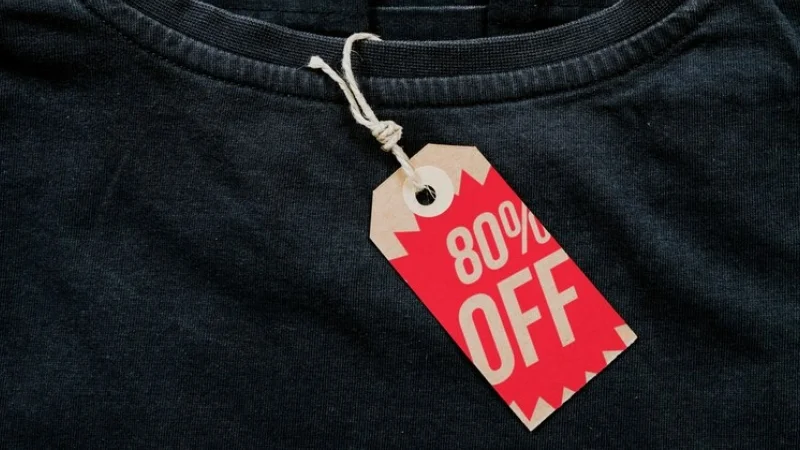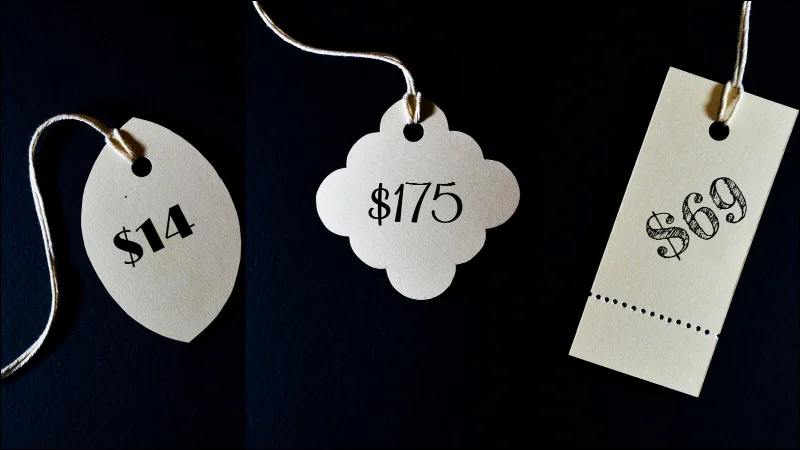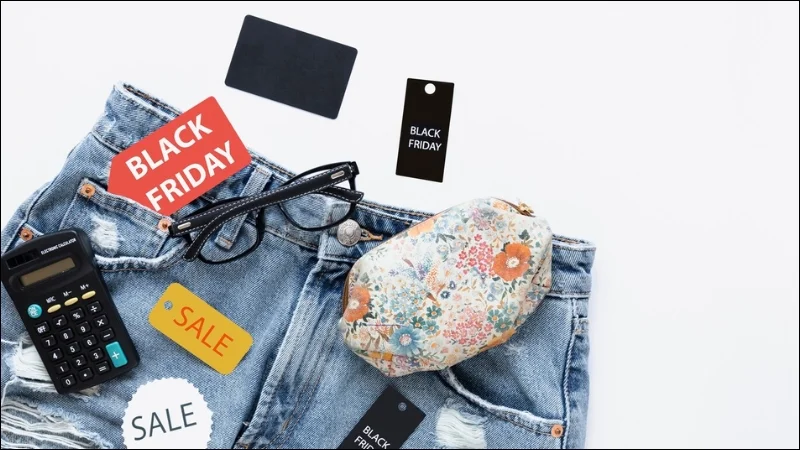Price Tag in Clothing: Function, Cost And Value Explained
Ubiquitous on nearly every garment offered for sale, the price tag serves a seemingly straightforward purpose: to state the cost. However, in the clothing industry, this small piece of paper or plastic carries significant weight beyond just numbers.
It’s a critical touchpoint performing essential functions, incurring specific costs for the business, and delivering multifaceted value that influences purchasing decisions and brand perception. This exploration delves into the vital role of the price tag, breaking down its core functions, the cost factors involved in its creation and implementation, and the often-underestimated value it provides to both the retailer and the customer. Let’s delve into these aspects.
1. What exactly is a price tag in the clothing world?
1.1 Defining the basics
Most recognize a price tag simply as a piece of paper or cardboard indicating how much an item costs. More precisely, the price tag serves as the physical identifier attached to a specific product primarily to display its selling price. This primary function is crucial for facilitating a sale in any retail environment. While often made from basic paper or slightly thicker cardboard, this tag is the direct signal of the cost associated with the merchandise.

1.2 Beyond the obvious
However, a price tag represents more than just the physical marker. Fundamentally, the indicated price signifies the agreed-upon cost or amount required to purchase the item in a retail transaction. The tag acts as a direct communication tool, conveying the product’s perceived value proposition to the potential buyer at the critical moment of consideration.
1.3 Context matters for clothing merchants
For businesses operating in the clothing industry, understanding the role of the price tag is particularly important. In this visually driven market, the tag is often the customer’s first tangible interaction with the cost of a piece of merchandise. A clear and professional price tag can significantly influence a purchasing decision, especially for impulse buys common in fashion retail. Furthermore, the quality and presentation of the tag subtly communicate brand professionalism, impacting how customers perceive the overall offering.
2. Anatomy of an effective clothing price tag
2.1 Must-have information
Certain details are non-negotiable for a functional price tag:
- Price: This is the core element. The stated amount must be absolutely clear, easy to read, and include the correct currency symbol (like $, €, £) relevant to your target sales market. Ambiguity here leads directly to confusion and potentially lost sales. The goal is unmistakable communication of the cost.
- SKU/Barcode: Essential for operational efficiency. The SKU (a unique code assigned to each distinct product) and its corresponding scannable barcode are fundamental for accurate inventory management and smooth point of sale (POS) operations. These allow for quick tracking, ringing up sales, and managing stock levels effectively.
2.2 Highly recommended information
Including these details significantly enhances the tag’s utility:
- Brand name/logo: Reinforces brand identity with every glance, building recognition.
- Size: Critical information for any clothing item, allowing customers to quickly identify suitable garments.
- Style name/number: Helps both customers and staff identify a specific product or design within your collection.
- Color: Useful for distinguishing between different variations of the same style, especially when multiple options are displayed together.
2.3 Optional, value-adding details
Consider these extras to further elevate your tag:
- Material composition snippet: Briefly listing key materials (e.g., “100% Cotton,” “Silk Blend”) adds perceived value and assists customers looking for specific fabrics or avoiding allergens.
- Website/social media handle: Turns the tag into subtle marketing collateral, encouraging customers to connect with your brand online.
3.1 Enabling the sale
A clear, accurate price tag is fundamental to completing a sale. Missing pricing information, illegible numbers, or confusing details create unnecessary friction during the checkout process. Customers faced with uncertainty about the cost may abandon their purchase altogether. Transparency in pricing, facilitated by a well-executed price tag, smooths the path from consideration to purchase.
3.2 Streamlining inventory
Accurate SKUs (stock keeping units) and scannable barcodes printed on each price tag are the backbone of efficient inventory control. This system allows for rapid stock counts, precise tracking of goods sold, significant reduction in shrinkage (loss due to theft or error), and streamlined reporting for replenishment. Effective inventory management relies heavily on the information embedded in these tags.
3.3 Shaping customer perception
The physical quality of price tags subtly influences how customers perceive your merchandise and brand. Professional, well-designed tags using quality materials contribute positively to the overall brand experience and enhance the perceived product value. Conversely, flimsy, poorly printed, or inconsistent tags can diminish trustworthiness and suggest lower quality, regardless of the actual garment. Attention to this detail reflects professionalism.
3.4 Implementing pricing strategies
Price tags are essential tools for executing various pricing strategies. Differentiating the tag design, color, or clearly marking the original price versus a sale price allows businesses to communicate discounts, clearance costs, or special offers effectively. This visual cue helps customers quickly understand value propositions and promotional activities.

3.5 A mini branding opportunity
Never underestimate the tag as a branding touchpoint. Every element, from the choice of materials (quality cardboard, recycled paper) to the consistent use of your logo, fonts, and colors, contributes to the overall brand aesthetic. Treating the price tag as an integral part of your visual identity reinforces your brand message at the point of purchase.
Understanding the different types of tags and labels attached to clothing is essential for proper production and clear communication.
These are primarily focused on communicating the cost of the garment and facilitating the sale. Key characteristics include their temporary nature – they are intended to be removed by the customer after purchase – and their external attachment to the garment, typically using a string or plastic fastener. In the industry, the term hang tag is frequently used interchangeably with price tag to describe this type of external tag or label.
4.2 Brand labels
The main purpose of brand labels is to showcase brand identity. Unlike price tags, these are usually permanent or semi-permanent fixtures on the garment. They are typically found sewn inside the clothing, often at the neckline or waistband, constantly reminding the wearer of the brand. This label (or tag) is integral to the garment’s branding.
4.3 Care labels
Care labels are functional and often mandated by compliance regulations. Their purpose is to provide specific washing and care instructions to help maintain the garment’s quality. Like brand labels, they are permanent and typically sewn inside the garment, frequently along a side seam. This label ensures customers know how to properly care for their purchase.
4.4 Size labels
As the name suggests, size labels clearly indicate the garment’s size (e.g., S, M, L, or numerical sizing). These are also permanent fixtures, sewn inside the clothing. Often, the size information is integrated into the brand label or care label, but sometimes exists as a separate small tag.
4.5 Why distinguishing matters
Knowing the difference between these tags and labels is vital for several reasons. Accurate identification ensures correct specifications during production, helps meet legal labeling requirements (especially for care and fiber content), provides complete customer information, and contributes to the professional presentation of the final product in a retail setting. Mislabeling can lead to issues with compliance, customer dissatisfaction, and operational inefficiencies.
| Tag Type | Purpose | Placement | Permanence |
|---|---|---|---|
| Price/hang tag | Communicate cost, facilitate sale | Externally attached | Temporary |
| Brand label | Display brand identity | Internally sewn | Permanent/semi-permanent |
| Care label | Provide care instructions, compliance | Internally sewn | Permanent |
| Size label | Indicate garment size | Internally sewn | Permanent |
Selecting the right price tag involves balancing practical needs with brand aesthetics.
5.1 Material & durability
Common material choices include standard paper, thicker cardstock, recycled options, and other sustainable materials. The choice impacts the tag’s durability – how well the tag holds up during handling on the sales floor – and the perceived value of the merchandise. Align the material with your brand image; a luxury item warrants a more substantial tag than a fast-fashion piece. Consider how much handling the garment will likely endure before purchase.
5.2 Size & shape
The size and shape of the tag affect both its functionality and its visual integration with the garment. A larger tag allows for more readable information, but might overwhelm a delicate item. A unique shape can enhance the design but might be impractical or costly. Choose dimensions that comfortably fit necessary details without detracting from the clothing itself.

5.3 Attachment method
How the tag is attached matters. Common attachment methods include various types of string (cotton, twine, ribbon), standard plastic fasteners, security loops, or safety pins (less common now). Factors to consider are the ease of application for your staff, the security needed (some fasteners are harder to remove and reattach), the overall cost, and the visual appeal relative to your brand.
5.4 Information hierarchy
Effective tag design requires a clear information hierarchy. Decide which piece of information is most important – usually the price – and make that the most prominent element through font size, weight, or placement. Secondary information like brand name and size should be clearly visible but subordinate to the price. Use visual cues to guide the customer’s eye logically through the details on the tag.
5.5 Printing & production
You have options for bringing your tag design to life. DIY printing using desktop printers and pre-cut stock offers flexibility and potentially lower initial cost, but can be time-consuming and may result in lower print quality or consistency.
Professional production services ensure high quality, consistency, and handle large volumes efficiently, though involve lead times and potentially higher setup costs. For businesses seeking professional results with custom options like unique materials or finishes, exploring specialized providers can yield tags that perfectly match their brand. Balancing cost, quality, volume needs, and time will guide your decision.
6. Related questions
6.1 What’s the difference between a price tag and a hang tag?
In everyday clothing retail language, price tag and hang tag are often used synonymously. They both generally refer to the external tag attached to a garment that displays the price and potentially other information like size or brand.
Technically, a “price tag” specifically emphasizes the price aspect, while “hang tag” could refer to any tag that hangs off the garment (even one without a price, though that’s less common in retail sales contexts). For most practical purposes in the apparel industry, these terms describe the same removable label.
6.2 Do I legally need specific information on a price tag in the US?
Federal legal requirements in the US, primarily overseen by the Federal Trade Commission (FTC), focus heavily on permanently attached labels specifying fiber content and care instructions. The price tag itself generally does not have federally mandated content requirements beyond ensuring the displayed price is clear and not deceptive or misleading about the cost.
However, businesses should always check for specific state or local regulations regarding pricing display and advertising. Ensuring compliance for the permanent care and fiber content labels remains critical.
Strategically designed and placed price tags or hang tags can act as a deterrent against “wardrobing” – the practice of buying an item, wearing the garment once, returning the item for a refund. Using large, highly visible hang tags, placing them in awkward or very noticeable locations (like the front exterior), or employing specific types of security fasteners that are difficult to remove and reattach without damage can make wearing the item with the tag attached obvious or uncomfortable. While not a foolproof solution, thoughtful tag design and placement can discourage this type of return fraud.
Read more:
Ultimately, the humble price tag carries significant weight for any clothing business. Far more than just a slip indicating cost, these tags are crucial operational tools supporting accurate inventory management and enabling a smooth sale.
They also serve as vital branding touchpoints. Thoughtful consideration of the tag’s design, the clarity of its information, the choice of material, and its overall presentation directly impacts the customer experience and the perceived product value.
Reviewing your current price tag strategy – from content to physical form – is a worthwhile exercise. For businesses seeking tailored solutions to optimize their labeling and packaging, exploring resources from specialized providers can offer valuable insights and ensure your tags effectively support both operations and branding.






















